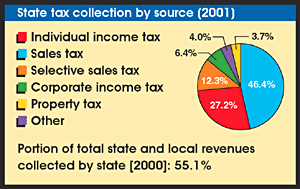A graph charting population growth in Arizona bears an uncanny resemblance to the state’s highest mountain, Humphrey’s Peak — except that the graph climbs even more sharply. Just 10 years ago, Arizona had 3.6 million residents. In 2000, its population was up to 5.1 million. In times as good as the late 1990s, when every new citizen was seen as a source of new revenue — in the form of additional sales, income and property taxes — it was assumed that more people were a blessing. But in the current conditions of scarcity, such rapid growth can give revenue estimators some of the same symptoms as climbing Humphrey’s Peak: dizziness, stomach pains and various symptoms of altitude illness.
Given the explosive growth, Arizona’s fiscal problems would have been daunting under any circumstances. But they’ve been especially severe thanks to $1 billion worth of tax cuts enacted in the late 1990s. Most were reductions in the personal income tax. Others reduced business taxes. A $50,000 exemption on personal property, for example, was designed to help small businesses cope with commercial property tax rates that were more than twice as high as residential rates.
Standout characteristics: Heavy reliance on sales tax; steep population growth puts pressure on services; supermajority vote required to increase taxes.
About these charts
But the biggest tax cut — and by far the most embarrassing — was an expansion of the tax rebate in 2000 for owners of alternative-fuel vehicles. Initial estimates pegged the cost at $3 million, but the giveback mushroomed into a $200 million debacle. Paying the bill required draining a third of the state’s rainy day fund.
”There was a false sense of complacency,” says state Representative Ruth Solomon of the Joint Budget Committee. “We should have been giving rebates, not changing the tax code. We should have recognized that at some point, things were going to go south.”
The combined result of all the cuts is a system more dependent than ever on the sales tax. This would present problems of fairness anywhere. But in Arizona it also leads to major confusion. The state and counties exempt food from their sales taxes but cities don’t. Localities are free to determine for themselves which other goods and services are taxable and which are not. A given product may be taxed several different ways in adjoining places. Consumers in La Paz County pay different rates on the same products than their neighbors to the east in Maricopa. Retailers are forced to comply with numerous tax codes — which require separate sets of books — depending on where they set up shop.
Last year’s flat sales tax receipts and declines in income tax revenue forced major spending cuts. The legislature sliced the 2003 budget by $1 billion, and even that likely will not be enough; economists now estimate a $250 million deficit by the end of the fiscal year in June, and the rainy day fund is dry. The once-welcome population growth now means bills that can’t be paid — rapidly growing numbers of students need schools, and the state’s disproportionate numbers of senior citizens need medical care.
Meanwhile, another ominous cost looms on the horizon: Last September, Arizona agreed to pay as much as $350 million to settle a class-action suit over its taxation of dividends. During the 1980s, the state illegally taxed dividends for in-state companies at a lower rate than those from out-of-state firms. The law has since been repealed, but as many as 600,000 taxpayers are eligible for refunds.
What’s the state to do? In Arizona, support for higher taxes has traditionally been the political equivalent of a jump off Humphrey’s Peak. Like many of its Western neighbors, Arizona has a visceral hatred of almost any new or higher tax. Sin taxes are the one exception they’re willing to tolerate: Last November, the voters approved a 60-cent hike in cigarette taxes, expected to raise about $150 million annually.
Moreover, Arizona’s residents haven’t been shy about using the ballot box to write their anti-tax ideology into law. When the legislature voted to raise taxes during the last recession, in the early 1990s, voters approved a ballot initiative requiring a two-thirds supermajority to pass future increases. Cutting taxes still needs only a simple majority. “It’s not a lesson lost,” says Kevin McCarthy, president of the Arizona Tax Research Association. “Policy makers are diving under their desks.”
Whispers about tax revision, though, are rising up from under the desks. “People have realized that we’ve used every fix we can,” says Solomon. A committee of legislators, government employees and private citizens has been assigned the task of reviewing the state’s tax code, with recommendations due by the end of the year.
An overhaul of a different kind is underway within the state’s Department of Revenue. It’s widely acknowledged that poor technology has hampered the department’s efforts at tax analysis, speedy tax processing and compliance control — and that there hasn’t been enough money appropriated for upgrades. “We have not done well by the Department of Revenue,” admits outgoing Senate President Russell Gnant. “They do not have the technology to effectively collect the taxes or to report to the legislature on the taxes they are collecting.”
The department is now three years into a complete reengineering process — expected to cost $122 million — that will revamp both the personnel structure and outdated technologies. Employees have been reorganized into teams built around functions, rather than specific taxes, and a vendor has been chosen to create an integrated tax information system.

FAST FACTS
Gross state tax revenues (rank): $8.5 billion (21)
State tax revenues per capita (rank): $1,593 (42)
State tax revenues as % of personal income (rank): 6.4% (30)
State and local taxes as % of personal income (rank): 11.2% (21)
Standout characteristics: Heavy reliance on sales tax; steep population growth puts pressure on services; supermajority vote required to increase taxes.
